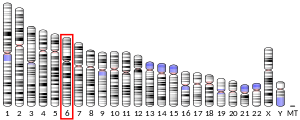FKBPL
FK506-binding protein like, also known as FKBPL, is a protein that in humans is encoded by the FKBPL gene.[4]
| FKBPL | |||||||||||||||||||||||||
|---|---|---|---|---|---|---|---|---|---|---|---|---|---|---|---|---|---|---|---|---|---|---|---|---|---|
| Identifiers | |||||||||||||||||||||||||
| Aliases | FKBPL, DIR1, NG7, WISP39, FKBP4, FK506 binding protein like, FKBP prolyl isomerase like | ||||||||||||||||||||||||
| External IDs | OMIM: 617076 MGI: 1932127 HomoloGene: 10529 GeneCards: FKBPL | ||||||||||||||||||||||||
| |||||||||||||||||||||||||
| |||||||||||||||||||||||||
| Orthologs | |||||||||||||||||||||||||
| Species | Human | Mouse | |||||||||||||||||||||||
| Entrez | |||||||||||||||||||||||||
| Ensembl |
|
| |||||||||||||||||||||||
| UniProt | |||||||||||||||||||||||||
| RefSeq (mRNA) | |||||||||||||||||||||||||
| RefSeq (protein) | |||||||||||||||||||||||||
| Location (UCSC) | Chr 6: 32.13 – 32.13 Mb | n/a | |||||||||||||||||||||||
| PubMed search | [2] | [3] | |||||||||||||||||||||||
| Wikidata | |||||||||||||||||||||||||
| |||||||||||||||||||||||||
Function
FKBPL has similarity to the immunophilin protein family, which play a role in immunoregulation and basic cellular processes involving protein folding and trafficking. The encoded protein is thought to have a potential role in the induced radioresistance. Also it appears to have some involvement in the control of the cell cycle.[5]
FKBPL is involved in cellular response to stress. It was first isolated in 1999 and was initially named DIR1.[6] It was later reclassified because of its homology to the FKBP family of proteins and was renamed FKBP-like (FKBPL). A separate study that found it to be involved in the stabilisation of newly synthesised p21 termed it Wisp39.[7]
It is known to interact with Hsp90, glucocorticoid receptor and dynamitin and may play a role in signalling, like other FKBPs.[8]
FKBPL has also been shown to influence estrogen receptor signalling and can have a determinant effect on response to the breast cancer drug tamoxifen.[9]
References
- ENSG00000230907, ENSG00000224200, ENSG00000223666 GRCh38: Ensembl release 89: ENSG00000204315, ENSG00000230907, ENSG00000224200, ENSG00000223666 - Ensembl, May 2017
- "Human PubMed Reference:". National Center for Biotechnology Information, U.S. National Library of Medicine.
- "Mouse PubMed Reference:". National Center for Biotechnology Information, U.S. National Library of Medicine.
- Robson TA, Lohrer H, Bailie JR, Hirst DG, Joiner MC, Arrand JE (February 1997). "Gene regulation by low-dose ionizing radiation in a normal human lung epithelial cell line". Biochem. Soc. Trans. 25 (1): 335–42. doi:10.1042/bst0250335. PMID 9056895.
- "Entrez Gene: FKBPL".
- Robson T, Joiner MC, Wilson GD, McCullough W, Price ME, Logan I, Jones H, McKeown SR, Hirst DG (November 1999). "A novel human stress response-related gene with a potential role in induced radioresistance". Radiat. Res. 152 (5): 451–61. doi:10.2307/3580140. JSTOR 3580140. PMID 10521921.
- Jascur T, Brickner H, Salles-Passador I, Barbier V, El Khissiin A, Smith B, Fotedar R, Fotedar A (January 2005). "Regulation of p21(WAF1/CIP1) stability by WISp39, a Hsp90 binding TPR protein". Mol. Cell. 17 (2): 237–49. doi:10.1016/j.molcel.2004.11.049. PMID 15664193.
- McKeen HD, McAlpine K, Valentine A, Quinn DJ, McClelland K, Byrne C, O'Rourke M, Young S, Scott CJ, McCarthy HO, Hirst DG, Robson T (July 2008). "A novel FK506-like binding protein (FKBPL) interacts with the glucocorticoid receptor and regulates steroid receptor signalling". Endocrinology. 149 (11): 5724–34. doi:10.1210/en.2008-0168. PMID 18669603.
- McKeen HD, Byrne C, Jithesh PV, Donley C, Valentine A, Yakkundi A, O'Rourke M, Swanton C, McCarthy HO, Hirst DG, Robson T (February 2010). "FKBPL regulates estrogen receptor signaling and determines response to endocrine therapy". Cancer Res. 70 (3): 1090–100. doi:10.1158/0008-5472.CAN-09-2515. PMID 20103631.
This article incorporates text from the United States National Library of Medicine, which is in the public domain.

